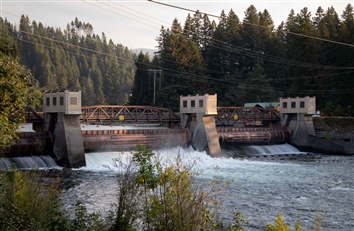Related News
Related News
-
Sustainability Snapshot - Celebrating Energy Efficiency Projects in the Community
Sustainability Snapshops highlight impactful projects completed by EWEB's Customer Solutions department, as a way to celebrate the meaningful work happening behind the scenes.
Find Out More -
McKenzie Valley electric service territory realignment study reaches key milestone
EWEB Commissioners approved a resolution authorizing the General Manager to negotiate and execute agreements with Lane Electric Cooperative regarding a potential realignment of electric service territory in the McKenzie Valley at the Board’s December meeting.
Find Out More -
EWEB Sets 2026 Budget and Rates, Advances Evaluation of McKenzie Valley Service Territory Realignment
Taken together, the 2026 budget and rate adjustments and the territory-realignment evaluation reflect EWEB’s dedication to responsible financial stewardship, modern, resilient utility infrastructure, and thoughtful planning for the future.
Find Out More -
EWEB secures $2.5 billion of reliable, affordable, carbon-free energy for customers
The new contract with EWEB’s largest energy supplier, the Bonneville Power Administration, forms the foundation of a diverse energy portfolio.
Find Out More -
Women in STEM: Meet the Hydro Project Engineer Building Habitat for Salmon
EWEB Engineer Associate Val Chang found her way to the McKenzie River from Los Angeles, inspired by heritage trips to the waters of Taiwan and key mentors along the way.
Find Out More -
Public Power Week Poster Contest Winners 2025
The results are in! View the winning posters from EWEB's 2025 Public Power Week Poster Contest.
Find Out More -
EWEB Hometown Heroes compete internationally
Out of 290 teams from 14 different countries, EWEB's Lineman Rodeo team places in the top third of competitors.
Find Out More -
EWEB's Halloween Truck-or-Treat is a huge success
Community members are accustomed to spotting EWEB trucks around Eugene streets and neighborhoods. But last week, those familiar vehicles looked a little different. At EWEB's second annual Truck-or-Treat Customer and Crew Appreciation Event, our fleet transformed into a festive Halloween spectacle.
Find Out More -
Let's Talk Turkey. Is your family ready for winter?
We're heading into the holidays, but that also means snow, ice, and not-so-nice weather might be in the forecast. Here are some tips to prepare in advance.
Find Out More -
Vote for your favorite Public Power Week Posters
The top five submittals will receive awards. Help us pick the winners.
Find Out More -
EWEB Hosts Annual Spill Drill to Protect McKenzie River
EWEB led emergency responders in its annual “spill drill” on the McKenzie River on Wednesday, Oct. 15, at the Trail Bridge Campground.
Find Out More -
Electric Projects underway in North & South Eugene
Underground lines and disaster-resilient power poles are part of EWEB’s infrastructure upgrade near Eugene’s largest natural resource area.
Find Out More -
EWEB general manager to retire in 2026
EWEB launches nationwide search for next leader to continue the progress of the last decade and ensure a smooth transition.
Find Out More -
The Bonneville Power Administration Rate Change and Your EWEB Bill
BPA’s finalized rate increase is smaller than projected, and EWEB’s pass-through adjustment effective October 1, 2025 will now be 2.7% for residential customers—down from the anticipated 4%.
Find Out More -
Quartz Creek: Setting the Stage for Floodplain Restoration
The project resets the floodplain along 1.8 miles of a formerly channelized creek to improve water quality, fish habitat and natural disaster resiliency.
Find Out More - Show More
EWEB Commissioners consider decommissioning Leaburg Hydroelectric Project
December 07, 2022

EWEB Commissioners voiced their support for decommissioning the Leaburg Hydroelectric Project at their Board Meeting on December 6.
General Manager Frank Lawson presented staff's recommendation to "permanently discontinue electricity generation at the Leaburg Hydroelectric Project," representing the findings of two years of in-depth analyses and an extensive public outreach process.
Internal erosion and seismically vulnerable soils among portions of the Leaburg Canal forced EWEB to shut down the hydroelectric project in 2018 and evaluate whether heavy investments into repairing the canal would be cost-effective, or if it is time for EWEB to decommission the 90-year-old project and cease generation.
The Leaburg project has historically generated about 4% of Eugene’s electricity needs. If EWEB were to continue generating, staff calculated the project would produce electricity at least three times more expensive than other carbon-free options.
EWEB will petition the Bonneville Power Administration (BPA), which already provides EWEB with about 80% of its energy, to replace the energy that would be lost by decommissioning Leaburg. EWEB will ask BPA to provide that additional energy at the low-cost, Tier 1 rate reserved for public power utilities across the region.
EWEB is already replacing the energy that the Leaburg project would create with Tier 1 BPA energy at $33 per Megawatt hour (MWh). Staff calculates the Levelized Cost of Energy to restore generation at Leaburg would produce electricity at $117/MWh.
In addition to economic considerations, Lawson points to the benefits that decommissioning Leaburg would yield to McKenzie River water quality and fisheries, as well as alignment with the utility’s core mission and customer-owner priorities to reduce costs.
“Permanently discontinuing electricity generation at the Leaburg Hydroelectric Project will result in the removal of the dam, restoring the McKenzie River to unobstructed flow and eliminating the human-made Leaburg Lake behind the dam,” Lawson writes. “EWEB’s mission does not directly prioritize creating or managing recreational facilities, transportation assets, or other non-electricity or drinking water activities,” Lawson states.
To maintain access to the south side of the river, Lawson recommends developing alternative access via Goodpasture Bridge.
All of the alternatives EWEB has studied would require capital investments tallying more than $150 million and would result in substantial rate increases over time. The recommended direction is the lowest-cost alternative. EWEB forecasts that this alternative might require the utility to raise electricity rates by 9-10% between 2023 and 2040.
“As a publicly owned utility, it’s our responsibility to make the best decision for our customer-owners while also being good stewards of the McKenzie River,” said Generation Manager Lisa Krentz. “This has been a difficult decision that includes significant trade-offs and impacts to our community. We look forward to continuing to work with our customers and upriver neighbors as we plan for the next steps of this project.”
Commissioners responded approvingly to staff's recommendation. Board President John Brown commended the team's diligence in its investigation. He repeated concerns about what would happen to the McKenzie Salmon Hatchery should the project no longer deliver water, and wondered what would happen to Lloyd Knox Park. Krentz acknowledged those are chief concerns the team would further investigate.
Commissioner John Barofsky said he was initially in favor of a full return to service, but as he learned more about the costs and considerations through the Triple Bottom Line Assessment he understands this decision and would even support a full decommissioning of the entire Leaburg Canal, rather than leaving the canal as a stormwater conveyance facility. Commissioner Matt McRae shared Commissioner Barofsky's interest in pursuing full decommissioning if economically feasible and practical.
Commissioner Mindy Schlossberg also supported the pursuit of a full decommissioning, pointing to the maintenance costs and liability of managing the canal's stormwater conveyance function rather than returning the creeks to their historical trajectories to the river.
Vice President Sonya Carlson reiterated that the rate impacts implied by any action are a major concern for her, acknowledging that the recommended option - Alternative 4, Decommissioning with Stormwater Conveyance and No Bridge - is the lowest cost option. She also emphasized the uncertainties of hydropower generation with continued river flow variances tied to climate change and regulatory restraints tied to fish protection.
Next steps:
- Lawson will prepare a Record of Decision for the Board to endorse decommissioning the project while leaving open the possibility to pursue full decommissioning in the future. The Record of Decision will set in motion an implementation and action plan towards decommissioning.
- If approved, EWEB anticipates several years of planning and settlement negotiations prior to construction commencing likely in the 2030s.
- Work on near-term risk reduction measure projects will start as soon as next year but the potential work to remove the dam and lake will likely not begin for 10 years or more.
- EWEB will continue to work with the community to learn how decommissioning the project would impact local water access, recreational opportunities, fisheries, and community economics.
Read the General Manager's Recommendation and the supplemental materials of the Triple Bottom Line Assessment: Goal #3(a): General Manager’s Recommendation - Leaburg Canal TBL & Strategic Assessment Final Findings
Watch the Board Leaburg discussion on EWEB's YouTube Channel:
Frequently Asked Questions about the Implications of Decommissioning Leaburg
- What does this recommendation mean for the Leaburg Project?
Dam Removal: This direction includes removing the Leaburg Dam, restoring the human-made Leaburg Lake to an unobstructed river, and building a road to connect properties that have used the dam as a bridge to the Goodpasture Bridge a few miles upstream.
Canal Repairs: EWEB would reinforce the Leaburg Canal to act as a stormwater conveyance facility, taking the tributary creeks that flow into the canal back to the McKenzie River. EWEB would modify sections of the canal to reconnect certain creeks directly to the river.
- Without the dam, will flooding be an issue?
The Leaburg Dam is a run-of-the-river facility, meaning it doesn’t play a role in reducing the impact of floods. The dam serves to direct water into the canal, rather than impounding water to store it for hydropower generation. When in operation, the dam would divert only a maximum of 2,500 cubic feet per second (cfs) of water into the canal and the rest of the McKenzie River would flow through the dam’s rollgates. Because the Leaburg Project is run-of-the-river, its generation potential is directly influenced by water availability – a further risk consideration as climate change threatens to reduce summer flows and therefore would likely reduce the amount of energy the project could produce.
- When will construction begin?
If approved, we anticipate several years of planning and settlement negotiations prior to any construction related to decommissioning. Major decommissioning work is not anticipated to commence until the beginning of the 2030s, at the earliest. Work on near-term risk reduction measure projects will start as soon as next year (i.e. canal plugs for directing stormwater and an outfall gate at Johnson Creek), but the work to remove the dam and lake will likely not begin for 10 years or more.
- How will this decision impact customer electricity rates?
We estimate the costs to carry out this decision would require EWEB to raise electric rates by 9-10% between 2023 and 2040.
- What about Irrigators and properties with water access?
EWEB will work to mitigate water rights and water access issues where legally obligated and facilitate water access where possible, specifically for fish hatcheries.
- How did EWEB communicate with the public about this decision?
We’ve held a dozen meetings with the Eugene and upriver communities this year and have presented at community meetings like the Springfield Lions, the Santa Clara Neighborhood Association, and the Eugene Chamber of Commerce. We’ve also reached out to 23 other neighborhood associations, worked with local media outlets to cover the project, and communicated the project to all customers on the September bill message. We received over 420 responses to a public comment form that was open from June through October and have compiled thousands of comments as part of assessing the social impacts of the Triple Bottom Line Assessment.

